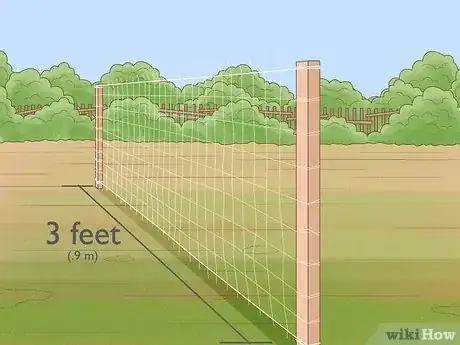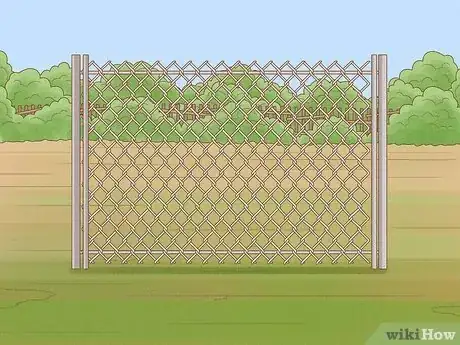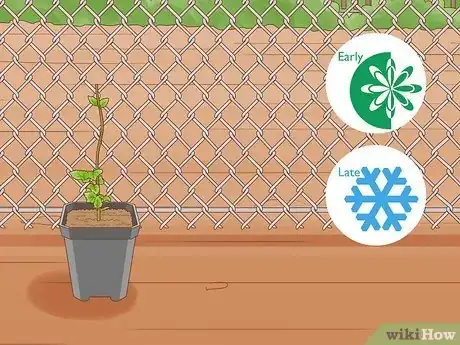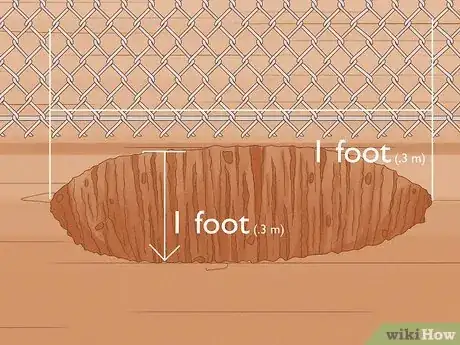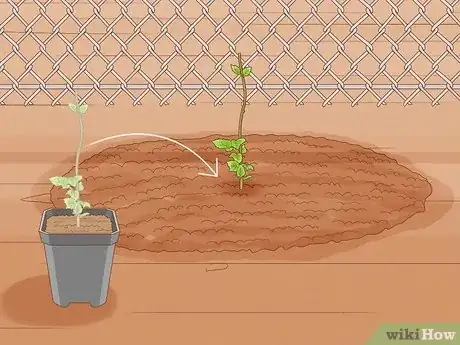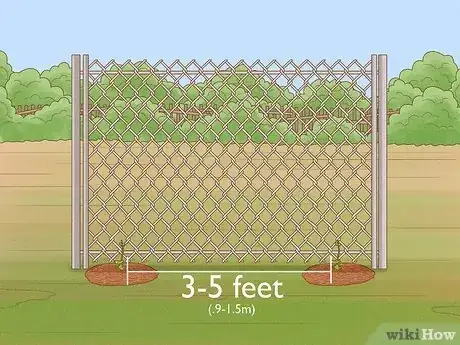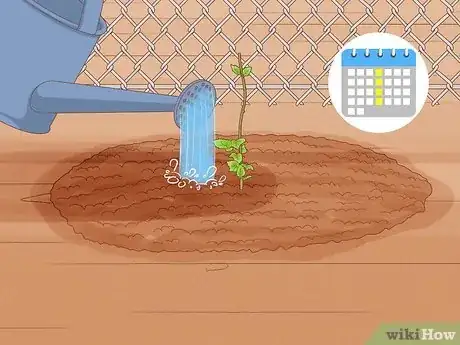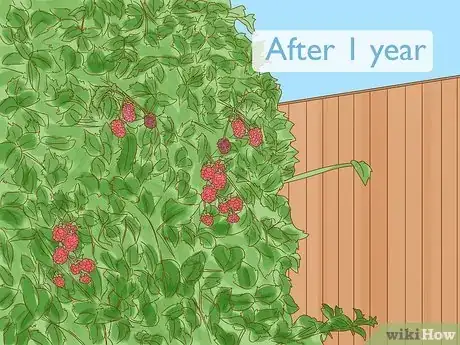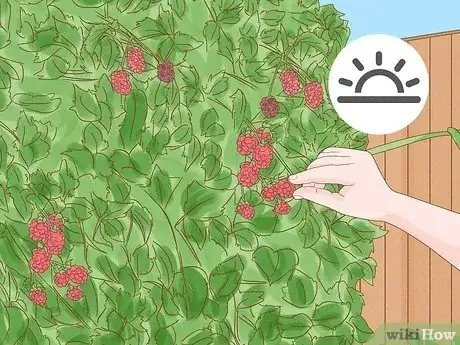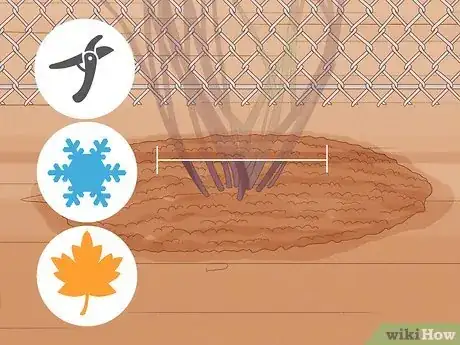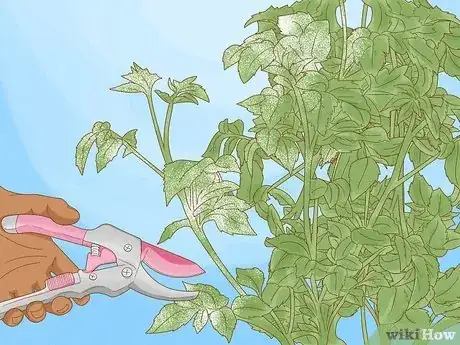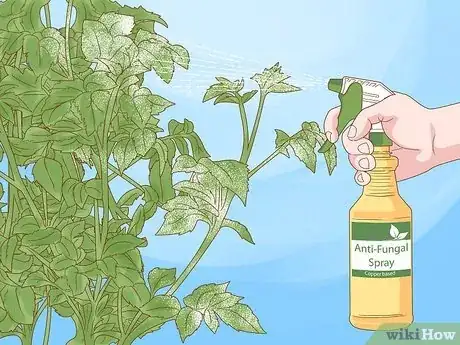This article was co-authored by Lauren Kurtz. Lauren Kurtz is a Naturalist and Horticultural Specialist. Lauren has worked for Aurora, Colorado managing the Water-Wise Garden at Aurora Municipal Center for the Water Conservation Department. She earned a BA in Environmental and Sustainability Studies from Western Michigan University in 2014.
There are 8 references cited in this article, which can be found at the bottom of the page.
wikiHow marks an article as reader-approved once it receives enough positive feedback. In this case, 80% of readers who voted found the article helpful, earning it our reader-approved status.
This article has been viewed 108,284 times.
Boysenberries are a hybrid of the raspberry family. They are a bramble bush, so they spread extensively if you let them. Giving them a trellis to cling to and pruning the canes at the end of the year are key factors of successful boysenberry growth. Get some seedlings from your local plant nursery, or order them online.
Steps
Setting up the Planting Area
-
1Choose a growing location in full sunshine. To get the best growth and flavor, make sure your berries get lots of sun throughout the day. It’s okay if they are in shade for part of the day, as long as they get a lot of sun. If your garden is partially shaded all day, plant boysenberries somewhere else.[1]
- Planting against a fence or house is useful for supporting plants, but make sure they’ll get enough sun.
- If you aren’t sure where to plant, watch your yard throughout the day to see where the best sunlight is.
-
2Check for well-drained soil. Boysenberries won't grow in soil that holds too much water. Pick a spot in your yard that drains well when you get a lot of rain. Don't plant anywhere that collects water. Soil that stays soaking wet will cause the plants' roots to rot.Advertisement
-
3Turn over the soil. Before planting for the first time, always till the soil really well. Use a power-tiller or a hand tool to turn the soil over to about one foot (.3 m) deep. You may need to water the soil to help loosen it. Depending on the size of the area, tilling may take a few hours.
- If you are planting somewhere that’s never been planted, tilling is even more important. If you’ve planted before, you don’t need to till quite as thoroughly.
- Boysenberries grow well in sandy, loamy, or clay-rich soil. They need moist soil, but they are also resistant to drought.[2]
-
4Build a trellis system. Boysenberries grow best with something to cling to. Set a pole in the ground at each end of a row of boysenberry plants. Make sure the poles stand three feet (.9 m) above the ground. String two pieces of wire, or a long piece of wire mesh, between the poles.[3]
- When you use two pieces of wire, attach one to the poles at three feet (.9 m) and the second at one and a half feet (.45 m).
-
5Adapt this trellis setup based on your space and available materials. Plant boysenberries next to a section of chain-link fence. If you don't have a fence around your yard, plant them near to a wall of your house or shed so the plants can cling to it. A fence allows you to tie the plants up, but a wall doesn't give you that option.
- The main goal is to plant the boysenberries near something they can cling to and be tied to. Otherwise, they will slump over and produce less fruit.
- Set up a ladder, an old kitchen chair, or stick a broom handle into the ground. Tie the plants to these to support them as they grow.
Transplanting Boysenberry Canes
-
1Plant at the end of winter or start of spring. Boysenberries go into dormancy during the winter season, so right before they start new growth is the best time to transplant. Check the soil on occasion, and plant when the ground has thawed after the last freeze of the season.[4]
- Boysenberries are pretty resilient in the face of cold weather, so they can handle if it stays cold for a little while after you plant them.
- Plants grow into full size throughout the summer.
-
2Dig one foot (.3 m) deep by one foot (.3 m) wide holes. Planting depth varies depending on the starting size of plants, but use this as a guide. Plant them about as deep as the container they start in. It’s better to start with a larger hole than you need because you can fill it in as needed.
-
3Add well-rotted compost or manure to the hole. Add at least a heaping handful of brown material compost or animal manure to the bottom of the hole. This helps give the plant a nutrient boost as it takes root in the soil. If you don’t have your own compost, buy some at a garden store.
- If you want to add a big shovelful, it won’t hurt. Also, mix some compost into the soil you’ll pack around the plant once you bury it.
-
4Place a plant into each hole. Once the growing area is all ready, place the plant into the hole. Shovel dirt around the roots and pack it down. Place a small layer of compost or manure around the base of the plant once it’s buried in the ground.
-
5Space boysenberry plants three to five feet (.9-1.5m) apart. Boysenberries keep growing as much as you let them. It’s important to give them a minimum of three feet (.9 m) to spread before they touch another plant. If you have the room, planing them five feet (1.5 m) apart leaves them plenty of room.
- If you don’t have much room, you may want to consider only planting one or two plants. Otherwise, set your plants up in more than one space in your yard so they have room to grow.
- Another option, if you have limited space, is to grow the plants in containers. However, keep in mind that container-grown plants will need heavy pruning in order to keep the plant from getting oversized.
Maintaining and Harvesting Boysenberries
-
1Water plants at least once a week. Pay attention to the rain and heat in your area. If it already rains at least once a week, you won’t need to do much watering. If it is extremely hot, you’ll need to water more often. A soil moisture meter helps you avoid wondering if the soil is wet enough.[5]
- Don't let the soil become dry. Get a soil moisture meter from your local garden store or order one online. This makes it so you don't have to guess if the soil is moist enough.
-
2Tie the main cane of each plant to the wire. Boysenberries are considered brambles, so they spread and expand. To keep the plants upright, tie them to the wires once they grow tall enough. The plants cling to the wire and expand outward along it.[6]
- Use twine or thin string to tie the plants up. Tie them first at the one and a half foot (.45 m) high wire, then at the three foot (.9 m) high wire.
- If you used wire mesh instead of wire, tie the plants at the same heights listed. If you planted along a fence or wall, adapt this tying method to help them cling to the surface.
-
3Wait a year for the plant to fruit. Most boysenberry plants need to grow for a full year before they actually produce fruit. Care for the plants throughout the year so you’ll have a full harvest of fruit to pick a year after you plant.
-
4Pick fruit in the morning. When your plants produce fruit, go out early in the morning to pick the berries off the plant. The berries are firmest in the morning, which is the best way to harvest them. Eat them, freeze them, or cook with them quickly because they don’t stay fresh for long.[7]
-
5Prune at the end of the season. Boysenberry plants will grow out of control if you let them, so always prune them carefully. Once a cane produces fruit, it won’t produce again during that growing season. Prune the old canes down to the ground in fall or winter.
- Cut the canes that produced fruit down to the ground. Also cut any withered or diseased-looking canes. Compost non-diseased canes for next season.
Protecting Boysenberries from Pests and Disease
-
1Harvest boysenberries immediately to discourage birds. Birds love boysenberries. To protect your plant from birds, harvest the berries as soon as they become ripe. If birds still manage to get to the ripe berries before you can, install bird netting over the plants.[8]
- Bird netting is most effective when installed 2-3 weeks before the berries are ready to be harvested.
-
2Keep your boysenberries dry. Boysenberry plants can easily become infected with fungus or mold if the foliage is regularly damp. When watering your plants, water the soil around the base of the plant, not the leaves. Regular pruning can also help improve air circulation and keep the leaves dry.
-
3Remove and destroy diseased canes. If your boysenberry plant shows signs of disease or infection, prune away any affected canes and branches immediately. Throw away or burn the canes so that the infection cannot spread to other plants.
-
4Use an anti-fungal spray for severe infections. If your boysenberries are afflicted by serious mold or fungus infections, use an anti-fungal spray. Most types of fungal infections can be treated with copper-based fungicides. For fruit rots, use benomyl or iprodione.[9]
- Always thoroughly wash berries from a plant that has been treated with fungicide. Use water with a fruit and veggie wash.
Expert Q&A
-
QuestionWhat is the difference between a blackberry and a boysenberry?
 Maggie MoranMaggie Moran is a Professional Gardener in Pennsylvania.
Maggie MoranMaggie Moran is a Professional Gardener in Pennsylvania.
Home & Garden Specialist They are part of the same berry family, and the boysenberry is a blend of blackberry, raspberry, and loganberry. The blackberry is a true berry and not a mix of any.
They are part of the same berry family, and the boysenberry is a blend of blackberry, raspberry, and loganberry. The blackberry is a true berry and not a mix of any. -
QuestionAre boysenberries good for you?
 Maggie MoranMaggie Moran is a Professional Gardener in Pennsylvania.
Maggie MoranMaggie Moran is a Professional Gardener in Pennsylvania.
Home & Garden Specialist They are healthy in many ways. They contain fiber, vitamin K, and a modest blend of manganese, iron, calcium, and potassium.
They are healthy in many ways. They contain fiber, vitamin K, and a modest blend of manganese, iron, calcium, and potassium. -
QuestionWhat do boysenberries taste like?
 Maggie MoranMaggie Moran is a Professional Gardener in Pennsylvania.
Maggie MoranMaggie Moran is a Professional Gardener in Pennsylvania.
Home & Garden Specialist They have a great juicy flavor and taste like a mix of blackberry and raspberry.
They have a great juicy flavor and taste like a mix of blackberry and raspberry.
References
- ↑ http://www.tuigarden.co.nz/howtoguide/berry-growing-guide
- ↑ https://www.rhs.org.uk/Plants/83398/Rubus-boysenberry,-thornless-(F)/Details
- ↑ http://www.gardeningblog.net/how-to-grow/boysenberries/
- ↑ https://permacultureprinciples.com/post/maximising-yield-from-boysenberries/
- ↑ http://www.monrovia.com/plant-catalog/plants/2055/thornless-boysenberry/
- ↑ https://www.rhs.org.uk/advice/profile?PID=93
- ↑ https://permacultureprinciples.com/post/maximising-yield-from-boysenberries/
- ↑ http://www.gardeners.com/how-to/protecting-berries-from-birds/7532.html
- ↑ https://plantdiseasehandbook.tamu.edu/food-crops/fruit-crops/blackberry-dewberry-and-boysenberry/
About This Article
To grow boysenberries, start at the end of winter or beginning of spring, and dig 1-foot deep by 1-foot wide holes that are 3-5 feet apart in a spot that gets a lot of sunlight throughout the day. Next, add compost or manure before setting a boysenberry plant in each hole and covering its roots with dirt. Once the plants are in, water them at least once a week to keep the soil moist. Additionally, set up a trellis, and tie your plants as they grow to keep them upright. Then, wait a full year after planting to harvest your boysenberries. For tips from our Gardening reviewer on how to protect your plants from pests and disease, scroll down!



